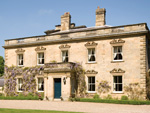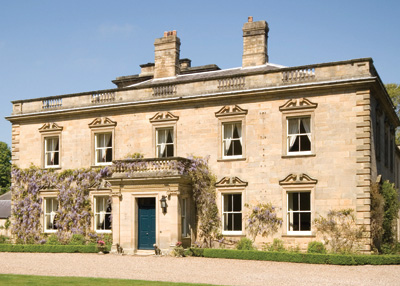Luxury property for sale in Northumberland
Penny Churchill takes a look at some outstanding historic properties for sale in Northumberland


Like characters in a novel by local author Barbara Taylor Bradford, the Sandersons of Eshott Hall, near Morpeth, Northumberland, have met with triumph and disaster on an epic scale, culminating earlier this year in a freak shooting accident that left charismatic businessman Ho Sanderson fighting for his life. Triumphs include the inspirational rebuilding and restoration of Classical, late-17th/early-18th-century Eshott Hall itself, dubbed ‘one of Northumberland's last great private family homes' by selling agents George F. White (01665 603231), who have launched it on the market at a guide price of £3 million.
An article by Mary Miers in Country Life (January 3, 2002) traces the curiously incomplete history of the Eshott estate from 1205, when King John granted its fertile lands between Morpeth and Alnwick to Robert fitz Roger, Lord of Warkworth. In the mid 17th century, the estate passed by marriage to the locally prominent Carr family. Various sources (including Pevsner) suggest that the original hall may have been built to the designs of Robert Trollope in 1660, by William Carr, who died in the early 1670s.
But Miss Miers argues in favour of his son, also William, as the more likely builder, given that ‘a date earlier than about 1700 is hard to justify on historic or stylistic grounds'. In any event, the Carr dynasty had collapsed by 1792, due to the reckless extravagance of Thomas Carr, who inherited in 1770, and the Eshott estate was sold to Thomas Adams of Alnwick for £34,000.

Eshott (pictured) was in a state of semi-dereliction when, in 1879, it was bought by industrialist Emerson Bainbridge, founder of the world's first department store, Bainbridge & Co of Newcastle. He set about creating ‘one of the handsomest halls... one of the most promising estates to be found in Northumberland', widening the house to the west and extending it northwards to include a three-storey tower. Although careful to retain the original floors and walls ‘wherever practicable',
Bainbridge made substantial alterations, including the creation of a handsome new library with a dining room (now a kitchen) behind and a grand staircase hall with a fine stained-glass stair window attributed to T. R. Spence, the architect of St George's, Jesmond. Bainbridge also redecorated the panelled vestibule and the drawing room, with its elaborate timber cornices, Corinthian pilasters, splendid chimneypiece and earlier Rococo-style plaster ceiling.
After Bainbridge's death, inheritances fragmented the estate and, by 1990, a family trust represented no fewer than 22 different owners, including Ho Sanderson, a fifth-generation descendant. It took Mr Sanderson seven years to negotiate a buy-out of the other shareholders, but, by 1997, he and his wife, Margaret, had regained control of Eshott Hall (by then, once more in danger of demolition) and its surrounding 500-acre estate.
Twelve years on, the hall has been lavishly rebuilt and restored under a management plan involving the architects Jane Darbyshire and David Kendall, which has included the replacement of a lost Victorian service wing demolished in the 1950s, the restoration of existing buildings, the reclamation of gardens, woodland and avenues, and the replanting of the 18th-century walled kitchen garden.
Sign up for the Country Life Newsletter
Exquisite houses, the beauty of Nature, and how to get the most from your life, straight to your inbox.
Currently run both as a family home and a Michelin-listed conference and hospitality centre, the resurgent Eshott Hall, listed Grade II, has an impressive range of opulent reception rooms, including the formal library, drawing room and dining room, and a recently built function room. There are nine first-floor bedrooms, six of which are en-suite, plus a further two bed-rooms in the second-floor tower block, and two self-contained luxury apartments. Also within the 35 acres are three charming holiday cottages created within the walls of the original stables.
With country houses in Northumberland always in short supply, joint agents Strutt & Parker (01670 516123) and Sale & Partners (01668 280801) are already reporting keen interest from potential purchasers in classic, late-Georgian Titlington Hall, near Alnwick, which hit the market in recent weeks at a guide price of £1.47m. Built in 1745 by Roger Pearson, the land agent and brother-in-law of the Earl of Tankerville of Chillingham Castle, the house was substantially remodelled in 1824 by William Pawson, who also owned nearby Leamington Hall and Shawdon Hall.
Titlington Hall, listed Grade II, stands in some 13 acres of delightful gardens, grounds, pasture and woodland and has four reception rooms, a splendid Regency stair-case, six bedrooms and four bathrooms, all impeccably refurbished by the present owners, who bought the hall from George Gale, former editor of The Spectator, in 1990. Period outbuildings with redevelopment potential include a fine stable block and a coach house with a dovecote.
The ancient village of Corbridge in the shadow of Hadrian's Wall, 18 miles west of Newcastle, was once the northern outpost of Roman Britain, and is now a favoured base for Newcastle commuters. The local office of Smiths Gore (01434 632404) quotes a guide price of £1.75m for roomy Hampstead House near Corbridge, a substantial stone-and-slate former farmhouse that may have been a dower house on the nearby Stagshaw House estate.
Extended and refurbished by the current owners since 2002, the 8,500sq ft house is enclosed by gardens to the south and west, and incorporates an adjoining two-storey former farmstead. It has a reception hall, three main reception rooms, five bedrooms, four bathrooms, a guest apartment, and a palatial leisure and games wing with an L shaped indoor pool, a gym and a snooker/games room.
Country Life is unlike any other magazine: the only glossy weekly on the newsstand and the only magazine that has been guest-edited by HRH The King not once, but twice. It is a celebration of modern rural life and all its diverse joys and pleasures — that was first published in Queen Victoria's Diamond Jubilee year. Our eclectic mixture of witty and informative content — from the most up-to-date property news and commentary and a coveted glimpse inside some of the UK's best houses and gardens, to gardening, the arts and interior design, written by experts in their field — still cannot be found in print or online, anywhere else.
-
 'Monolithic, multi-layered and quite, quite magnificent. This was love at first bite': Tom Parker Bowles on his lifelong love affair with lasagne
'Monolithic, multi-layered and quite, quite magnificent. This was love at first bite': Tom Parker Bowles on his lifelong love affair with lasagneAn upwardly mobile spaghetti Bolognese, lasagne al forno, with oozing béchamel and layered meaty magnificence, is a bona fide comfort classic, declares Tom Parker Bowles.
By Tom Parker Bowles Published
-
 Country houses, cream teas and Baywatch: Country Life Quiz of the Day, April 24, 2025
Country houses, cream teas and Baywatch: Country Life Quiz of the Day, April 24, 2025Thursday's Quiz of the Day asks exactly how popular Baywatch became.
By Toby Keel Published
